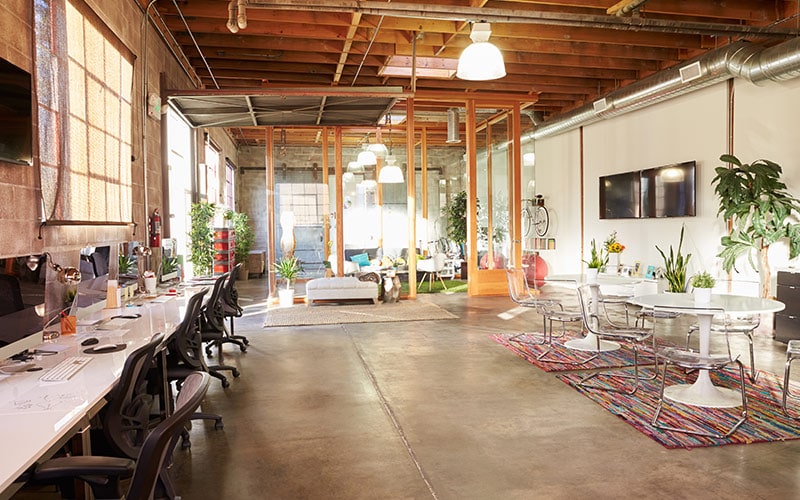Insights
- Workplaces need to go the human-centric way to create happy and high-performing employees.
- This will require them to incorporate structural and cultural changes that address their employees’ needs, wants, and challenges.
- Promoting an environment of flexible working and wellness, mixed with access to user-friendly technology that helps employees deliver superior work, and training to use it, is the key.
- This can help companies weave in human-centricity into their fabric, and create a workplace that employees actually enjoy working in.

A clear-cut divide between the office and home is a thing of the past. The last few years have seen the lines blur, aided by the increase of remote working during the pandemic – a work arrangement that continues, accompanied by hybrid working – and flexible working. In all this, one thing is clear – workplaces need to be more human-centric, and those that are will thrive, as happier employees mean increased productivity. While creating a human-centric workplace comes with challenges, by changing existing norms, humanizing technology, investing in suitable practices, and ensuring that the transformation aligns with business goals, companies can achieve this state and drive holistic success.
What makes a workplace human-centric
Human-centric workplaces are those where the management puts employees first and is clued in to their needs and pain points. These aspects are a driving force in designing organizational processes and infrastructure that address employee issues instead of solely meeting business goals. The aim is to provide employees with the best experiences through the solutions, where the employees are active participants in making decisions regarding employee engagement initiatives to implement, whether they are related to working arrangements, new technologies, or wellness. It is worth noting that human-centricity goes beyond just structural changes and attempts to pay equal attention to the culture of the organization.
Human-centricity goes beyond structural changes and also focusses on the culture of the organization.
Case for human-centric workplaces
- The market is increasingly competitive. Companies that need to grow and stay on top need to constantly innovate. Positive outcomes can be possible only when the people working in a business can work in a way that suits both the organization and the individuals.
- With a growing focus on sustainability, companies need to create systems that solve the problems of their people through technology and infrastructure, and the solutions are long-lasting and durable. Making changes that keep people at the core will mean that changes are planned in a mindful manner and not haphazardly, saving time and resources.
- For organizations that are trying to call back employees to the office, it is important they create a space that is also physically human-centric – one that is capable of drawing people to the workplace, and inspires them to be motivated to work from the office, collaborate with their teams, and feel connected in the workplace.

The idea of a human-centric workplace not just lends an air of progressiveness to the employer, it also offers tangible benefits for the organization. Research by Gartner shows that employees who work in human-centric work models are 3.8 times more likely to be high performing. The study shows employees are also 3.2 times more likely to want to stay in the company, and 3.1 times more likely to experience lower fatigue levels. Another piece of research also shows the link between employee engagement levels and profitability.
The building blocks
- When it comes to making human-centric transformations, organizations need to gather and analyze data about the current behavior, experiences, and problems of their employees, rather than study historical data. The main reason for this is, the workspace is constantly evolving and only the most recent data can help bring relevant change that impacts the lives of employees.
- Offering flexibility in terms of work location and timings allows employees to have more control over their daily lives, be it at work or home. It also spreads the message that the company trusts its employees to be accountable for their output regardless of where they are working from.
-
It involves investing in and providing access to technology that can help employees work more quickly and efficiently, and produce superior-quality work. Humanizing technology is a large part of creating a human-centric workplace. This essentially means designing systems that are user-friendly and engaging for the employee, and not just a tool to perform a task, similar to that in Infosys Workplace Suite.
WongDoody’s Design System Nexus – an accelerator – helps businesses create, roll out, and evolve a complex design system by bridging design and cross-platform code. It helped a leading satellite company unify their internal business platforms and interfaces under one design system generating capital and operational cost savings.

Humanizing technology is a large part of creating a human-centric workplace.
-
In another case, Infosys and WongDoody were tasked with enabling employees of a Middle Eastern smart city access to shared services. Using Infosys’s award-winning employee experience framework, InfyMe, they designed a platform with a single interface to the tools, knowledge and support required to work in the smart city. This gave users a centralized, easy-to-use common experience layer that delivered the information, tools, platforms, and services they needed to work efficiently and effectively. The team created personalized experiences that sit on top of the client’s technical stack of microservices to allow seamless navigation for all users.
“Employees now expect the same level of intelligence and intuitiveness within enterprise tools as they do when interacting with consumer-facing applications from Google, Amazon, and Uber. Unfortunately, many enterprise tools and applications are falling short. These systems are often disjointed and inconsistent, forcing employees to navigate complex workflows to complete even basic tasks,” says Ralf Gehrig, chief experience officer at WongDoody. “To bridge this experience gap, organizations must couple human-centred design principles with emerging AI capabilities. This shift towards a user-centred workplace will not only enhance employee engagement but also unlock new levels of productivity and innovation in the workplace.”
-
Another aspect of humanizing technology is enabling employees to understand how to use it well, through training and upskilling. AI-led knowledge management can help companies analyze individual learning patterns and preferences to create personalized learning paths for their employees. AI learning experts say that this is an integral feature of human-centric workplaces. AI can adjust the difficulty levels of a course based on an employee’s performance, and pace the learning materials accordingly. Infosys’s The Future of Work 2023 research shows how the fastest growing companies have been rushing to automate their tools and modernize their technology, while hiring more diverse talent, and focusing on reskilling, which together are estimated to add 7.7 percentage points to profit growth and 6.7 percentage points to revenue growth.
The fastest growing companies have been rushing to automate their tools and modernize their technology, while hiring more diverse talent.

-
Embedding human-centricity requires companies to devise empathetic and creative ways, that stray from tried-and-tested methods, to improve employee experiences. Boingo promotes health and wellness among its employees, particularly for home office workers, by organizing novel events such as virtual sound baths and chair yoga.
An MIT Sloan Management Review survey shows that 72% of managers and executives strongly agree it is important they work for an organization with a purpose they believe in. Leaders should communicate the values of the company clearly so they can resonate with the employees. Buffer, a social media management tool, is known for maintaining transparency with its employees, so much so that it publishes the salaries of all its employees online to address the issue of gender pay gap. Netflix’s culture of freedom and responsibility among its employees has become a reference point for other companies.
- Human-centricity requires a cultural change in the environment, and promoting a blame-free space where employees get to learn from their mistakes, and steps are taken to improve the system of working to reduce errors and achieve desired results. It is also an environment where leaders make an effort to check in with employees regularly, and seek their opinions on critical matters, making them feel seen and heard.
Organizations should note that human-centricity isn’t a goal that needs to be met and ticked off their list, never to be revisited. It is an iterative process that will require them to continually mold and improve their ways of working to meet the changing conditions and needs of employees.






